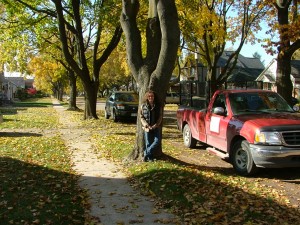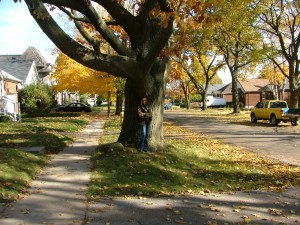It’s vitally important for the future of our urban canopy that we plant species that are suited to where they will do their best. Think about the opposite situation – plant the wrong kind of tree in a place where it will probably die?
Trees and shrubs prefer a range of growing conditions. Some have narrow preferences and others are generalists. The species you see widely planted all over that are healthy are probably generalists and these can be a safe bet when it comes time to decide what to plant.
But, if you have the right soils, sun and moisture it makes sense to plant species that are rare or require uncommon growing conditions. It’s the only way we’ll have a diversity of species in the City, not all the same species everywhere. And you can have something unusual too.
Also, while a species may survive in a place, you also want it to thrive (i.e. grow really well) not just barely survive. Here’s an example. Look at these two tree pictures. Both are on the same street in Etobicoke. Both look like they were planted at about the same time (mid 1950’s when the houses were built).
This is a Norway Maple tree planted on the boulevard in the 1950’s. It is about 55cm DBH and is starting to split apart from old age. About 80% of the trees on the street are Norway Maples and most look like this now. It’s one of the larger diameter maple trees on the street, and some have already been taken out because of rot. They have reached the end of their service lives and the City is starting to take them down as they break apart in storms or get diseased.
Now look at this tree. This is one of only 3 Red Oaks planted on the street – right across the street from the previous maple picture. This tree looks like it was planted at the same time as all the maples but it’s over twice as large in diameter as the maples, and the crown isn’t starting to fall apart from old age. It’s about 1/3 taller than the maples too. It has many years of healthy and safe life left.
These examples illustrate the cost of not planting the right tree in the right place. The neighbourhood has dry sandy soils – well suited to Red Oaks but only ‘OK’ for Norway Maples. The maples are dying out prematurely and becoming a hazard for residents, while the oaks will continue to thrive for many more decades. The oaks are a much better investment of time and money than the maples. Imagine this scenario being played out across the city with many species and you’ll see part of the reason we pay so much for tree maintenance and replacement. It also shifts some of the cost onto future generations – the people who will have to remove and replace the maples are us, not the people who planted them.
So how do you get the right tree in the right place?
1. Determine the soil and moisture conditions for your site. Do soil tests or pits. If you don’t know how, hire someone. It’ll save you time and money.
2. Make a list of candidate species that will grow under those conditions.
3. Plant the best suited one (or two), or the one that suits your other objectives.
We can help. Call us!


